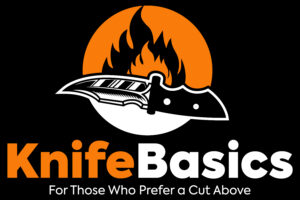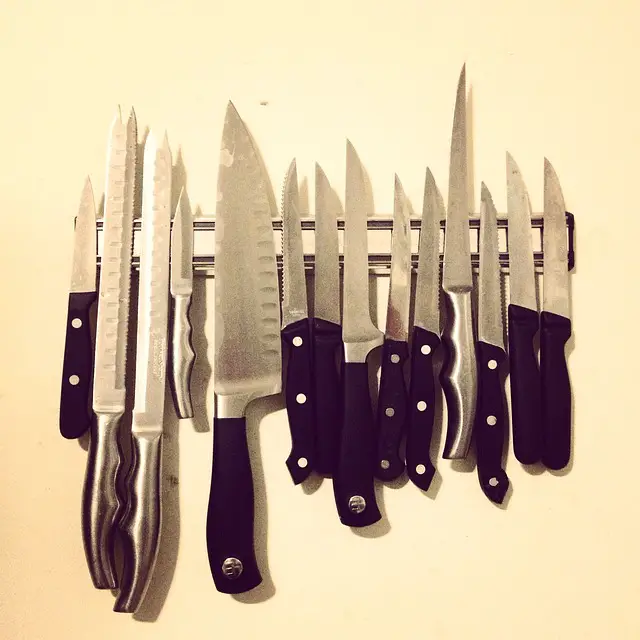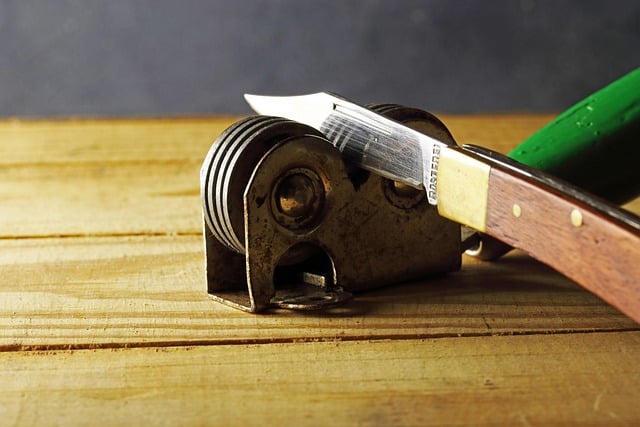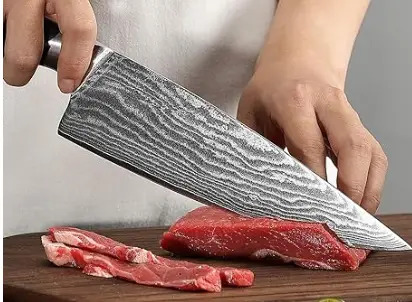Are you tired of struggling with dull, ineffective knives in the kitchen? The answer to all your cutting challenges lies in the power of steel. With the ultimate knife guide, you can unleash the full potential of steel and transform your cooking experience.
In this comprehensive guide, we will walk you through everything you need to know about knives and the different types of steel used in their construction. We’ll dive deep into the intricacies of blade composition, hardness, and edge retention, giving you a clear understanding of what sets a high-quality knife apart.
Whether you’re a professional chef or an avid home cook, choosing the right knife can make all the difference in your culinary journey. Our expert tips and recommendations will help you navigate the vast array of options available, ensuring you find the perfect tool to suit your needs.
From slicing and dicing to chopping and mincing, mastering the art of cutting is a game-changer in the kitchen. So don’t settle for less than the best. Join us as we explore the cutting edge of steel and unlock the full potential of your knives.
The Importance of Having the Right Knife
Having the right knife is essential for any kitchen enthusiast. A good knife is not only a pleasure to use but also a valuable tool that can enhance your cooking skills. The right knife can make your chopping tasks easier, more efficient, and even more enjoyable. On the other hand, a dull or poorly designed knife can be frustrating to work with and can even pose a safety risk.
When it comes to knives, quality matters. A high-quality knife is durable, holds its edge well, and provides excellent control. It allows you to make precise cuts, ensuring that your ingredients are prepared exactly as you intend. A well-balanced knife with a comfortable handle reduces fatigue and makes it easier to handle for extended periods.
Investing in a good knife is an investment in your cooking skills. It can save you time and effort in the kitchen, allowing you to focus on what matters most – creating delicious meals for yourself and your loved ones. So, let’s dive into the world of knives and discover the power of steel.
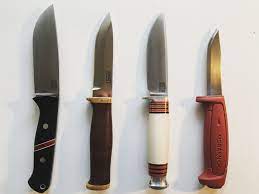
Types of Knives and Their Uses
Knives are available in a variety of shapes and sizes, each designed for specific tasks in the kitchen. Understanding the different types of knives and their intended uses is crucial for selecting the right tool for the job.
- Chef’s Knife: The chef’s knife is a versatile, all-purpose knife with a broad blade and a slightly curved edge. It is ideal for chopping, slicing, and dicing fruits, vegetables, meats, and herbs. The length of a chef’s knife typically ranges from 6 to 12 inches, with an 8-inch blade being the most popular choice among professionals and home cooks.
- Paring Knife: The paring knife is a small, narrow-bladed knife with a pointed tip. It is perfect for delicate tasks such as peeling, trimming, and precise cutting. The blade length of a paring knife is usually around 3 to 4 inches, making it easy to maneuver and control.
- Bread Knife: A bread knife features a long, serrated blade designed to effortlessly slice through crusty bread without crushing it. The serrated edge allows the knife to grip the bread’s surface, ensuring clean, smooth cuts. A typical bread knife has a blade length of 8 to 10 inches.
- Santoku Knife: The santoku knife is a Japanese-style knife with a shorter, wider blade and a straighter edge compared to a chef’s knife. It excels at slicing, dicing, and mincing, making it a popular choice for Asian cuisine. The blade length of a santoku knife is usually around 5 to 7 inches.
- Utility Knife: The utility knife is a smaller version of a chef’s knife, typically with a blade length between 4 to 6 inches. It is a versatile tool that can handle a wide range of cutting tasks, from trimming and slicing small fruits and vegetables to deboning poultry.
Understanding the different types of knives and their intended uses is the first step in finding the right knife for your kitchen. Next, let’s delve into the world of steel and explore the different types of steel used in knife construction.
Understanding the Different Types of Steel
The type of steel used in a knife plays a crucial role in determining its performance. Different types of steel have varying levels of hardness, corrosion resistance, and edge retention. Let’s take a closer look at some popular types of steel used in knife blades:
- Stainless Steel: Stainless steel is a popular choice for kitchen knives due to its excellent resistance to corrosion and staining. It is easy to maintain, making it ideal for everyday use. However, stainless steel typically has lower hardness compared to other types of steel, which means it may require more frequent sharpening.
- High Carbon Stainless Steel: High carbon stainless steel combines the benefits of stainless steel and high carbon steel. It offers good corrosion resistance and edge retention while providing better hardness and sharpness compared to regular stainless steel. High carbon stainless steel knives are a popular choice among professional chefs.
- Damascus Steel: Damascus steel is known for its distinctive patterned appearance, created through a process of layering and forging different types of steel. It is highly regarded for its exceptional strength, sharpness, and edge retention. Damascus steel knives are often considered works of art due to their beautiful patterns and excellent performance.
- Carbon Steel: Carbon steel knives are renowned for their exceptional sharpness and edge retention. They are easy to sharpen and can achieve an incredibly fine edge. However, carbon steel is more prone to corrosion and requires proper care to prevent rusting. Carbon steel knives are favored by many professional chefs for their superior cutting performance.
- Ceramic: Ceramic knives are made from a high-tech ceramic material called zirconium oxide. They are extremely hard, lightweight, and retain their sharpness for a long time. Ceramic blades are non-reactive, meaning they won’t alter the taste or smell of food. However, they are more brittle than steel knives and can chip or break if mishandled.
Choosing the right type of steel for your knife depends on your personal preferences, intended use, and maintenance routine. Factors such as hardness, corrosion resistance, and ease of sharpening should be considered when making your decision. Now that you have a better understanding of steel, let’s explore the key factors to consider when choosing a knife.
- 【Exclusive Built-in Sharpener】Kitchen knife set with sharpener is amazing. The self-sharpening block keeps the knives razor sharp effectively. It saves you from having to honing blades on a sharpening steel.
- 【Premium Knife Set】Made of forged, high-carbon one-piece German stainless steel, this cutlery knife block set is tarnish-resistant and rust-resistant. The knife set is well-made with a nice appearance. They are sharp, durable, and have good weight and balance, providing effortless cutting. Perfect for both professional chefs and beginner.
- 【Easy to Clean Up】: The kitchen knife set with block is easy and fast to clean. Hand-wash for best results. The blades are stainless and rust-free after going through washing.
- 【Easy to Store】: All knives are stored safely in the knife block with built-in sharpener for space efficient storage. The block is easy to clean and maintain. It is durable and doesn't take up too much space on the counter. Made of natural rubberwood,this wooden kitchen knife block is strong and sturdy to hold heavy knife sets and is finished with a beautiful veneer that’s naturally resistant to grime and easy to wipe clean
- 【Best Sharp Knife Set】Optimized weight and good balance make this kitchen knife set fit nicely in the palm of hand. Exclusive taper grind edge technology provides optimum sharpness for precise cutting and is easy to re-sharpen. The knives are sturdy and can handle heavy chopping. The knives set stays sharp even after extended use.
- Multipurpose Knife Set: This kitchen knives set includes 8" Chef Knife, 8" Slicing Knife, 7" Santoku Knife, 8" Serrated Bread Knife, 5" Utility Knife, 3.5" Paring Knife, Kitchen Shears and 6 pcs Blade Guards
- Anti-rust coating: The healthy anti-rust coating protects the knife from oxidation and dishwasher safe, while the non-stick coating ensures the blades stay clean all day long
- Easy to carry: Each knife comes with a blade guard for safe, compact storage in your kitchen cupboard. These knives are also easy to carry when camping or storing in your RV
- Perfect Holiday Gift: Ideal for kitchen enthusiasts or new cooks, this knife set meets all cooking needs. It makes an excellent holiday gift for family, friends, lover and colleague
- Lifetime Warranty: Every knife set is backed by rigorous quality inspection, we provide a lifetime warranty for every customer, ensuring superior customer service and peace of mind with every purchase
- ULTRA-SHARP BLADES: Superior professional-level sharpness that ensures precision cutting.
- THE LAST KNIFE YOU’LL EVER NEED TO BUY: German Engineered Knife Informed by over 100 Years of Mastery. HENCKELS knives are built to last.
- EFFORTLESS CUTTING: Enjoy easy cutting with minimal effort with this lightweight, easy-to-use knife.
- SET INCLUDES: 3-inch paring knife, 5-inch serrated utility knife, 7-inch santoku knife hollow edge, 8-inch chef's knife, 8-inch bread knife, 4.5-inch steak knife set of 6, professional honing steel, kitchen shears, and hardwood knife block
- QUICK CLEAN UP: No-fuss cleanup, in the dishwasher or by hand. Stain and rust-free blades.
Factors to consider when choosing a knife
Finding the perfect knife for your needs starts with understanding the factors that contribute to its performance. The first thing to consider is the type of steel used in the blade. Different types of steel have varying levels of hardness, corrosion resistance, and edge retention. For example, stainless steel blades are popular for their corrosion resistance, while high carbon steel blades are known for their exceptional sharpness and edge retention. Consider your cooking style and preferences to determine which type of steel is best suited for you.
Another crucial factor to consider is the blade shape. Knives come in a variety of shapes, each designed for specific tasks. The most common blade shapes include the chef’s knife, paring knife, bread knife, and santoku knife. A chef’s knife, with its broad and curved blade, is versatile and suitable for a wide range of cutting tasks. On the other hand, a paring knife, with its small and narrow blade, is perfect for intricate tasks like peeling and trimming. Understanding the different blade shapes and their specific applications will help you choose the right knife for the job.
The handle of the knife is also an important consideration. It should be comfortable to hold and provide a secure grip. Handles can be made of various materials, such as wood, plastic, or metal. Each material has its own advantages and disadvantages, so it’s essential to choose one that suits your preferences. Additionally, the weight and balance of the knife can greatly affect its usability. Some people prefer a heavier knife for more control, while others prefer a lighter one for ease of use. Consider how the knife feels in your hand and choose a weight and balance that feels comfortable and balanced.
Maintaining and sharpening your knives
Once you’ve invested in a high-quality knife, proper maintenance and sharpening are essential to keep it performing at its best. Regular cleaning and drying after each use will help prevent corrosion and keep the blade in optimal condition. Avoid placing knives in the dishwasher as the harsh detergents and heat can damage the blade and handle. Instead, hand wash them with warm water and mild soap, then dry them thoroughly before storing.
Sharpening your knife is a skill that every cook should master. Over time, the blade will dull from use, and regular sharpening is necessary to maintain its cutting performance. There are various sharpening methods available, including sharpening stones, honing rods, and electric sharpeners. Each method has its own advantages and requires a different technique. Whichever method you choose, it’s important to follow the manufacturer’s instructions and take your time to ensure a sharp and precise edge.
The best knives for specific tasks
In the vast world of kitchen knives, there are specific knives designed for different tasks. Understanding their purposes and characteristics will help you choose the best knife for each job.
- Chef’s Knife: The chef’s knife is the workhorse of the kitchen. With its broad and curved blade, it’s suitable for a wide range of tasks, from slicing and dicing to chopping and mincing. Look for a chef’s knife with a comfortable handle and a blade length of around 8 to 10 inches for versatility.
- Paring Knife: The paring knife is perfect for intricate tasks that require precision, such as peeling, trimming, and scoring. Its small and narrow blade allows for greater control and maneuverability. Choose a paring knife with a sharp and pointed tip for maximum precision.
- Bread Knife: A bread knife is essential for slicing through crusty bread without crushing it. Its serrated blade allows for clean and effortless cuts, ensuring your bread stays intact. Look for a bread knife with a long and thin blade to easily glide through bread without tearing it.
- Santoku Knife: The santoku knife is a versatile Japanese knife that excels at slicing, dicing, and chopping. It features a shorter and wider blade compared to a chef’s knife, making it ideal for precise and swift movements. Consider a santoku knife with a granton edge, which features small oval-shaped divots along the blade to prevent food from sticking.
Expert tips for using knives effectively
Using a knife effectively requires more than just choosing the right one. Here are some expert tips to help you make the most out of your knives:
- Maintain a proper grip: Hold the knife firmly but not too tightly. Use a pinch grip, where you grip the handle between your thumb and index finger, for maximum control and maneuverability.
- Master the rocking motion: When using a chef’s knife or santoku knife, practice the rocking motion. This involves keeping the tip of the knife on the cutting board while rocking it back and forth with a downward pressure. This technique allows for efficient and precise chopping.
- Let the knife do the work: Avoid applying excessive force when cutting. A sharp knife should glide through ingredients effortlessly. Applying too much pressure can lead to accidents and damage the blade.
- Use a cutting board: Always use a cutting board to protect your knives and your countertops. Opt for a board made of wood or plastic, as hard surfaces like glass or granite can dull the blade quickly.
- Regularly hone your knife: In addition to sharpening, regular honing of the blade with a honing rod will help maintain its sharpness between sharpenings. Hold the rod at a slight angle and glide the knife along the rod, alternating sides.
Knife accessories and storage solutions
To keep your knives in top condition and ensure their longevity, consider investing in some essential knife accessories and storage solutions.
A knife sharpener, such as a sharpening stone or an electric sharpener, is a must-have tool for maintaining the sharpness of your knives. Choose one that suits your sharpening preferences and skill level.
A honing rod is another useful accessory for regular maintenance between sharpenings. It helps realign the blade’s edge, keeping it sharp and precise.
When it comes to storage, a knife block or magnetic strip is a popular choice. A knife block keeps your knives organized and readily accessible on the countertop, while a magnetic strip allows you to display and store your knives on the wall, saving valuable counter space.
If you prefer to store your knives in a drawer, consider using blade guards or a knife roll to protect the blades and prevent accidents when reaching in.
Conclusion: Finding the perfect knife for your needs
Choosing the right knife is a personal journey that depends on your cooking style, preferences, and needs. By understanding the factors that contribute to a knife’s performance, maintaining and sharpening your knives, and using them effectively, you can unlock the full potential of steel and transform your cutting experience in the kitchen.
Remember to consider the type of steel, blade shape, handle, weight, and balance when choosing a knife. Regular maintenance, proper sharpening techniques, and using the right knife for each task will ensure optimal performance and longevity.
Investing in high-quality knives and essential accessories, such as a sharpener and honing rod, will help you maintain the sharpness and precision of your blades. Choose a storage solution that suits your space and preferences, whether it’s a knife block, magnetic strip, or knife roll.
With the ultimate knife guide in your hands, you can confidently navigate the vast world of kitchen knives and unleash the power of steel. Say goodbye to dull and ineffective knives, and welcome a new level of cutting excellence in your culinary journey.
